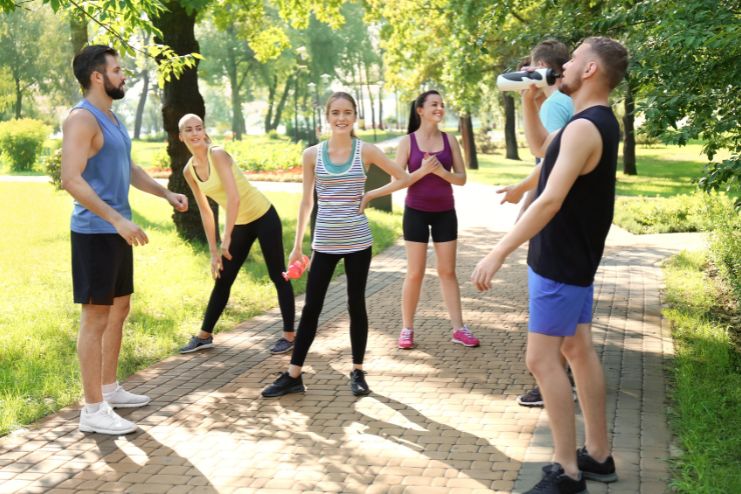Affiliate Disclaimer
Some links in this article are affiliate links. We may earn a small commission if you make a purchase through these links, at no extra cost to you. We only recommend products we find useful to our readersThirty-day workout plans and their constantly circulating viral trends have taken the wellness sector by storm, luring millions with promises of speedy and stunning results. By their very nature, these programs tend to be “one-size-fits-all” answers to health goals, with easy access for men and women wishing to shed pounds, build muscle, or perhaps even lead a more active life.
These have surged into prominence by several social media platforms, with fitness influencers and their equally celebrated before-and-after photos urging their followers to attempt such challenges as an element of fun and quick-fix solutions, making it all the more attractive in an age where instant gratification is slowly becoming an addiction.
However, beneath the surface of these trends lies a critical need to question their long-term impact and associated risks for fitness challenges. Are these challenges sustainable, or do they foster unhealthy practices, such as overexertion and a hyper-focus on appearance?
As the fitness industry continues to evolve, it is crucial to examine how these challenges align with the broader health and well-being goals, ensuring they promote sustainable, positive lifestyle changes rather than temporary, superficial gains.
READ MORE: Challenges for a Fun and Effective Workout
The Hidden Risks of Fitness Challenges

Exercise has numerous physical and mental health advantages, making it essential to a healthy lifestyle. But moderation is vital, just like anything else in life. Regarding exercise, the fitness culture has recently embraced the notion that “more is better.”
However, even something beneficial might turn dangerous if exercise is not done in moderation. Let us examine some of the hidden risks of fitness challenges.
Overtraining and Injury

High-intensity or repetitive workouts significantly increase the risk of overtraining injuries like stress fractures, tendinitis, and muscle strains. The absence of adequate rest and recovery aggravates overuse injuries by hindering tissue repair. Chronic stress from over-exercising symptoms may lead to adrenal insufficiency, resulting in fatigue, mood swings, sleep disturbances, and a weakened immune system.
Additionally, continuous over-exercising triggers inflammation, which suppresses immunity and increases vulnerability to illness. Without proper rest and nutrients, muscle breakdown can occur instead of muscle growth, hindering fitness progress. Over time, excessive exercise can weaken bones, increasing the likelihood of stress fractures and other bone issues.
Intentional rest days are essential for recovery, muscle repair, and preventing overtraining injuries to achieve fitness goals safely. Prioritizing sleep and balanced nutrition supports bone health, immune function, and overall well-being, ensuring a sustainable and effective fitness journey.
Unrealistic Expectations

Fitness challenges driven by fitness trends and dangers often emphasize aesthetics or numerical achievements, disregarding individual fitness levels and personal needs. This narrow focus encourages unhealthy comparisons, leaving participants feeling inadequate or frustrated when goals are not achieved.
The mental toll includes stress, reduced self-esteem, and burnout, potentially negating the benefits of physical activity. By prioritizing unattainable ideals, these trends can push individuals toward overtraining and neglecting essential recovery, further risking physical harm.
Instead, fitness goals should be realistic and personalized, focusing on health and progress over perfection. Emphasizing self-improvement and overall well-being fosters a positive relationship with exercise, ensuring sustainable motivation and long-term success.
Nutritional Deficiencies and Extreme Diets

Engaging in fitness challenges while adhering to extreme calorie restrictions poses significant fitness challenges and risks, leading to severe nutritional deficiencies. These restricted diets frequently deprive the body of vital nutrients for immune system function, muscle regeneration, and energy production. As a result, people may become tired, have a lower ability to exercise and be more likely to get hurt.
Extreme dietary restrictions can also impair long-term health, interfere with metabolic processes, and foster a negative relationship with food. These behaviors may potentially aggravate mental and physical health issues by promoting disordered eating patterns.
Adopting a nutrient-dense, well-balanced diet that meets the body’s energy needs during exercise is crucial to reducing these dangers and guaranteeing efficient recovery and long-lasting performance. A safe and long-lasting fitness quest requires putting health and well-being before appearance or numbers.
Ignoring Individual Needs

Engaging in one-size-fits-all fitness challenges, disregarding factors like age, medical history, and fitness levels, poses significant health risks. These generic programs often neglect personal needs, leading to overexertion, injury, or aggravation of existing health conditions.
For example, individuals with underlying medical issues may face adverse effects from high-intensity workouts that are not tailored to their capabilities.
Similarly, younger and older participants have different physiological responses to exercise, which generic routines fail to address. Ignoring these individual differences can result in burnout, decreased motivation, and serious health complications. Emphasizing safe workout routines tailored to personal needs is essential for preventing injury and ensuring sustainable progress.
Personalized exercise regimens that align with unique characteristics and goals promote a healthier, more effective fitness journey. Prioritizing individualized care encourages long-term engagement and minimizes the risks associated with generalized fitness challenges.
How to Approach Fitness Challenges Safely

Engaging in fitness challenges can be an excellent way to boost motivation and achieve health goals. However, it is essential to approach these challenges safely to prevent injury and ensure long-term success.
Personalization is Key
Customizing workout challenges to your unique requirements is critical. Factors including your age, medical history, and current level of fitness should guide your exercise program. Generic programs might not meet your unique needs, which could result in overwork or damage. A skilled trainer’s advice can help create a customized plan that fits your talents and objectives.
Include Rest Days
Adding rest days to your fitness routine is vital for muscle recovery and overall progress. Continuous exercise without adequate rest can lead to overtraining, diminishing performance, and increasing the risk of injuries. Rest days allow your body to repair and strengthen, contributing to sustainable improvement.
Consult Experts
Seeking advice from healthcare professionals or certified trainers ensures your fitness approach is safe and effective. They can provide guidance on proper techniques, appropriate intensity levels, and suitable exercises tailored to your individual needs. Professional input helps prevent injuries and achieve optimal results.
Focus on Sustainability
Opting for sustainable exercise plans over short-term challenges promotes long-term health benefits. Health-focused fitness programs emphasizing gradual progress and consistency are more effective than intense, short-lived regimens. Sustainable plans reduce the risk of burnout and encourage a lifelong commitment to physical activity.
Alternatives to Traditional Fitness Challenges

Traditional fitness challenges often emphasize rapid results and high-intensity regimens, which can lead to physical strain and the mental toll of fitness challenges, including stress and burnout.
By shifting focus from high-pressure fitness challenges to balanced routines and supportive community programs, individuals can achieve their health goals while minimizing stress and promoting long-term well-being.
Balanced Workout Routines
Instead of accepting extreme challenges, you should build an exercise program that balances cardiovascular exercise, strength training, and flexibility exercises. A plan that is good for overall fitness but will prevent the risk of injury would be more appropriate.
Such a program might include aerobic exercise like running or cycling for cardio, weightlifting, bodyweight exercises for strength, yoga, or stretching for flexibility; it is a good, balanced, and sustainable approach.
Community-Based Fitness Programs
Joining community-based fitness programs can provide a supportive environment that prioritizes health and inclusivity over competition. These programs frequently emphasize group activities that promote motivation and a sense of belonging.
Engaging in such inclusive fitness communities can alleviate the mental pressures associated with traditional fitness challenges, making exercise a more enjoyable and sustainable part of your lifestyle.
Conclusion

Health and fitness are lifelong pursuits that need balance, consistency, and mindfulness. Know that fitness is not a sprint but rather an individual journey toward wellness. Focusing on sustainable habits rather than temporary trends creates a foundation for long-term success.
Paying attention to your body is one of the most critical components of fitness. Overtraining and neglecting signs of fatigue can lead to serious setbacks, including injuries and burnout. Incorporate workout recovery tips into your routine to prioritize safety and well-being.
Schedule the days you have to rest, drink appropriate amounts of fluid (maintaining hydration), and constantly develop a regimen of stretching and proper nutrition that fosters muscle repair and growth. Adequate sleep is also vital, allowing your body to recover and perform at its best.
Adopt habits that fit your lifestyle by encouraging a balanced approach and avoid fad fitness trends. During this process, when recovery, personalization, and gradualness are emphasized, the risk of injury is lowered, and the training process becomes more enjoyable and sustainable.
Prioritizing yourself for health ensures fitness remains an empowering force in your life in the years to come.
References
- https://www.leeboyce.com/the-dark-side-of-fitness-and-health-that-no-one-talks-about/
- https://www.refinery29.com/en-gb/workout-challenges-negative-impact
- https://www.bannerhealth.com/healthcareblog/advise-me/the-dark-side-of-fitness-influencers-on-social-media
- https://www.signos.com/blog/dangers-of-over-exercising
- https://www.drfranklipman.com/post/finding-balance-the-hidden-risks-of-overexercising-on-your-health
- https://www.iol.co.za/sunday-tribune/lifestyle/the-hidden-dangers-of-overtraining-how-pushing-your-limits-can-harm-your-body-04af105c-d387-4876-89b0-ae9c2b6dbd56
- https://medium.com/@garyfoowk/overtraining-the-hidden-danger-of-strength-training-bd9beed0b7e7
- https://www.wellsteps.com/blog/2020/01/02/office-challenge-ideas-office-fitness-challenges/
- https://www.mayoclinic.org/healthy-lifestyle/fitness/in-depth/fitness/art-20048269
- https://www.health.harvard.edu/healthbeat/10-tips-for-exercising-safely
- https://allianceortho.com/building-a-balanced-workout-routine-strength-cardio-and-flexibility/
- https://www.rally.club/blog/creating-a-balanced-workout-routine-combining-cardio-strength-and-flexibility
- https://blog.infs.com/2024/10/03/combining-cardio-strength-and-flexibility-mobility-exercises-for-overall-well-being/
- https://www.self.com/story/fitness-tips-new-year
In this Article

















